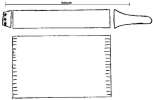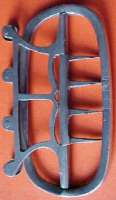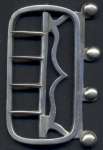| INDEX | 1300-1599 | 1600s | 1700s | 1800s | 1900s | CROSS-ERA | ETHNO | |
| MISCELLANY | CONTACT | SEARCH | |
There is a number of varieties of men's cravats, but the lacy bibs most often seen in films are not among them. They are an invention of the 19th century. What men actually wore was either a kind of scarf loosely knotted at the neck with the ends hanging down, or a stock such as is described here.
The best suited material for a stock is fine white linen or possibly cotton. If the material is the same as for the breast and cuff ruffles, all the better.
 Left:
Pattern diagramme, click to enlarge.
Left:
Pattern diagramme, click to enlarge.
The pattern is as straightforward as they come: two rectangles and two also
roughly rectangular end pieces. One rectangle is not quite as long as the neck
circumference - about 5 cm less - and as wide as you want the stock to be, i.e.
depending how high you want it to go up the neck. If the fabric is very fine,
you'll need at least two layers, maybe even an interlining. The stock is supposed
to stay standing after all. Actually I suggest using a stiffer, less fine linen
for this part, but fine enough not feel uncomfortable on the neck.
The other rectangle is as long, but four or five times as wide. Just how much wider it is depends largely on how fine the fabric is and how much patience you have: The wider rectangle is laid into lots of minute parallel pleats until it is as wide as the narrower one. The pleats are about 5-7 mm deep, leaving 2-3 mm. The pleats have to be ironed in.
The pleated rectangle is then sewn onto the other, edges folded to the inside. It is a good idea to baste each fold onto the base fabric along the inner fold of each pleat. That may be awfully time-consuming, but it will save you a lot of time later: A stock will have to be washed often, and each time you would have to redo every single pleat.
The end pieces consist od two layers each, made up like short tunnels. One is about 3-4 cm long and as wide as the stock along one edge, a bit narrower along the other - or maybe not narrower, depending on the size of the buckle (see below). The other end piece is about 10 cm long, again as wide as the stock along one edge, and considerably narrower on the other. As you have probably already concluded, the end pieces are joined with the stock along their wider eges.





The shorter end piece receives three or four small buttonholes, and the stock
is finished. It is placed on top of the turned-up collar of the shirt and closed
at the back with the help of a special buckle, known as stock buckle (see pictures
above). Its four (or sometimes three) little knobs go through the buttonholes
of the shorter end piece, while the longer end piece is threaded through the
buckle and pierced by the tongues. The one with the black picture background
(click to enlarge) is sterling silver, the frame 4.9 x 2.5 cm and the overall
measurements 5.1 x 3.2 cm. Both silver and pewter are common materials, but
gold, bronze, brass, and cut steel are also possible.
Now the problem is that such stock buckles are hard to get by nowadays. I know of only one supplier of repros, Godwin. If you have no access to a stock buckle, the stock has to be changed a little. You may, for instance, use a knee buckle that has lost its counterpart. In that case, forget about the little buttonholes and replace them with a larger, horizontal one just large enough to receive the bow of the knee buckle. If you don't have a knee buckle either, you may use buttons or ribbons, but you will have to shorten the longer end piece so that there's no overlap.
Content, layout and images of this page
and any sub-page of the domains marquise.de, contouche.de, lumieres.de, manteau.de and costumebase.org are copyright (c) 1997-2022 by Alexa Bender. All rights reserved. See Copyright Page. GDPO
This work is licensed under a Creative Commons License.